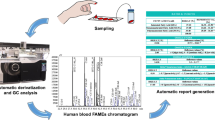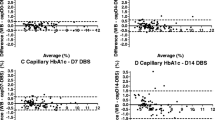Abstract
An assay involving a finger stick and filter paper blood spotting was developed to determine polyunsaturated fatty acid (PUFA) levels in blood. Capillary whole blood from a finger stick was blotted on antioxidant impregnated filter paper, air dried, saponified and methylated using sodium hydroxide and boron trifluoride in methanol. The method differed from those described previously because separation of plasma and red blood cells (RBCs) was not needed, thin-layer chromatography (TLC) was not required to separate phospholipids, initial extraction of lipids before transesterification was not necessary, and the fatty acid methyl ester (FAME) method was able to methylate steryl esters, free fatty acids, and sphingomyelins. Twenty-six subjects provided blood samples by finger stick and venipuncture. Levels of long-chain polyunsaturated fatty acids (LC-PUFA) from capillary whole blood were correlated with those from RBCs and PLs in venous blood (P < 0.001, R 2 ranged from 0.64 to 0.86). Although highly significant (P < 0.002), the R 2 values for the correlation between arachidonic acid (ARA) levels in capillary whole blood with ARA levels in RBCs and plasma phospholipids (PLs) were relatively lower (R 2 = 0.31–0.41, respectively). Results indicate that the described finger stick assay represents a fast, reliable method to measure specific LC-PUFA levels.


Similar content being viewed by others
Abbreviations
- AOCS:
-
American Oil Chemists’ Society
- ARA:
-
Arachidonic acid
- DHA:
-
Docosahexaenoic acid
- DPAn-6:
-
Docosapentaenoic acid
- EPA:
-
Eicosapentaenoic acid
- FAME:
-
Fatty acid methyl esters
- LC-PUFA:
-
Long-chain polyunsaturated fatty acids
- PLs:
-
Plasma phospholipids
- PUFA:
-
Polyunsaturated fatty acids
- RBCs:
-
Red blood cells
- TLC:
-
Thin-layer chromatography
References
Ohta A, Mayo MC, Kramer N, Lands WEM (1990) Rapid analysis of fatty acids in plasma lipids. Lipids 25:742–747
Inoue K, Suzuki Y, Yajima S, Shimozawa N, Orii T, Kondo N (1997) Very long chain fatty acid analysis of dried blood spots on filter paper to screen for adrenoleukodystrophy. Clin Chem 43:2197–2198
Ichihara K, Waku K, Yamaguchi C, Saito K, Shibahara A, Miyatani S, Yamamoto K (2002) A convenient method for determination of the C 20–22 PUFA composition of glycerolipids in blood and breast milk. Lipids 37:523–526
Marangoni F, Colombo C, Galli C (2004) A method for the direct evaluation of the fatty acid status in a drop of blood from a fingertip in humans: applicability to nutritional and epidemiological studies. Anal Biochem 326:267–272
Morrison WR, Smith LM (1964) Preparation of fatty acid methyl esters and dimethylacetals from lipids with boron fluoride-methanol. J Lipid Res 5:600–608
Kohn G, van der Ploeg P, Mobius M, Sawatzki G (1996) Influence of the derivatization procedure on the results of the gas chromatographic fatty acid analysis of human milk and infant formula. Z Ernahrungswiss 35:226–234
Folch J, Lees M, Sloane Stanley GH (1957) A simple method for the isolation and purification of total lipids from animal tissue. J Biol Chem 226:497–509
Bligh EG, Dyer WJ (1959) A rapid method of total lipid extraction and purification. Can J Biochem Physiol 37:911
Innis SM (2007) Dietary (n-3) fatty acids and brain development. J Nutr 137:855–859
Agostini C, Trojan S, Bellu R, Riva E, Giovannini M (1995) Neurodevelopmental quotient of healthy term infants at 4 months and feeding practice: the role of long-chain polyunsaturated fatty acids. Pediatr Res 38:262–266
Hoffman DR, Birch EE, Castaneda YS, Fawcett SL, Wheaton DH, Birch DG, Uauy R (2003) Visual function in breast-fed term infants weaned to formula with or without long-chain polyunsaturates at 4 to 6 months: a randomized clinical trial. J Pediatr 142:668–677
Uauy R, Hoffman DR, Mena P, Llanos A, Birch EE (2003) Term infant studies of DHA and ARA supplementation on neurodevelopment: results of randomized controlled trials. J Pediatr 143:S17–S25
Morale SE, Hoffman DR, Castaneda YS, Wheaton DH, Burns RA, Birch EE (2005) Duration of long-chain polyunsaturated fatty acids availability in the diet and visual acuity. Early Hum Dev 81:197–203
SanGiovanni JP, Berkey CS, Dwyer JT, Colditz GA (2000) Dietary essential fatty acids, long-chain polyunsaturated fatty acids, and visual resolution acuity in healthy full-term infants: a systematic review. Early Hum Dev 57:165–188
GISSI-Prevenzione Investigators (1999) Dietary supplementation with n-3 polyunsaturated fatty acids and vitamin E after myocardial infarction: results from the GISSI Prevenzione trial. Lancet 354:447–455
von Schacky C (2003) The role of omega-3 fatty acids in cardiovascular disease. Curr Atheroscler Rep 5:139–145
Harris WS (2005) Extending the cardiovascular benefits of omega-3 fatty acids. Curr Atheroscler Rep 7:375–380
Moore C, Bryant S, Mishra G, Krebs J, Browning L, Miller G, Jebb S (2006) Oily fish reduces plasma triacylglycerols: a primary prevention study in overweight men and women. Nutrition 22:1012–1024
Mori TA, Bao DQ, Burke V, Puddey IB, Beilin LJ (1999) Docosahexaenoic acid but not eicosapentaenoic acid lowers ambulatory blood pressure and heart rate in humans. Hypertension 34:253–260
Leaf A, Kang JX, Xiao YF, Billman GE, Voskuyl RA (1999) The antiarrhythmic and anticonvulsant effects of dietary n-3 fatty acids. J Membr Biol 172:1–11
Pischon T, Hankinson SE, Hotamisligil GS, Rifai N, Willett WC, Rimm EB (2003) Habitual dietary intake of n-3 and n-6 fatty acids in relation to inflammatory markers among US men and women. Circulation 108:155–160
Green KN, Martinez-Coria H, Khashwji H, Hall EB, Yurko-Mauro K, Ellis L, LaFerla FM (2007) Dietary docosahexaenoic acid and docosapentaenoic acid ameliorate amyloid-β and tau pathology via a mechanism involving presenilin 1 levels. J Neurosci 16:4385–4395
Lim GP, Calon F, Morihara T, Yang F, Teter B, Ubeda O, Salem Jr N, Frautschy SA, Cole GM (2005) A diet enriched with omega-3 fatty acid docosahexaenoic acid reduces amyloid burden in an aged Alzheimer mouse model. J Neurosci 25:3032–3040
Morris M, Evans D, Bienias J, Tangney CC, Bennett DA, Wilson RS, Aggarwal N, Schneider J (2003) Consumption of fish and n-3 fatty acids and risk of incident Alzheimer disease. Arch Neurol 60:940–946
SanGiovanni JP, Chew EY (2005) The role of omega-3 long-chain polyunsaturated fatty acids in health and disease of the retina. Prog Retin Eye Res 24:87–138
Arterburn LM, Oken HA, Hoffman JP, Bailey-Hall EB, Chung G, Rom D, Hamersley J, McCarthy D (2007) Bioequivalence of docosahexaenoic acid from different algal oils in capsules and in DHA-fortified food. Lipids (in press)
Author information
Authors and Affiliations
Corresponding author
About this article
Cite this article
Bailey-Hall, E., Nelson, E.B. & Ryan, A.S. Validation of a Rapid Measure of Blood PUFA Levels in Humans. Lipids 43, 181–186 (2008). https://doi.org/10.1007/s11745-007-3140-7
Received:
Accepted:
Published:
Issue Date:
DOI: https://doi.org/10.1007/s11745-007-3140-7




